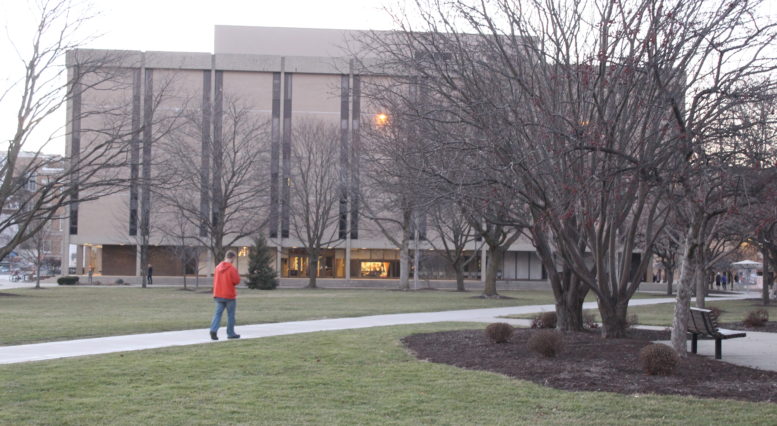By ANDREW BAILEY
BG Independent News Correspondent
BGSU’s Human Development and Family Studies program is now offering a new child life minor, which sets students on the pathway toward serving children during difficult times.
But child life specialists’ jobs are not as simple as serving children, so the minor has a family-centered approach, according to Dr. Jean Gerard, one of the co-chairs of the minor and associate professor in HDFS.
“We take an integrated approach. This is not just serving children,” Gerard said. “But also helping families deal with what their children are going through. We see it as a very family systems-based approach.”
The minor requires 21 to 23 credit hours, including practicum, Gerard said.
Child life specialists help children and their families deal with “difficult or unexpected experiences, such as chronic illness, hospitalization, the death of a loved one, or the aftermath of violent acts or natural disasters,” the Association of Child Life Professionals’ website explains.
This is especially important in hospital settings, where children may have to deal with complex procedures to combat life-threatening illnesses or injuries.
According to an Associated Press article from 2020, child life specialists explain procedures and treatments child patients have to go through in language that is understandable and appropriate for them.
With the purpose that child life specialists serve in mind, Gerard and her co-chair, Stephanie Blessing, assistant teaching professor and internship coordinator for HDFS, began creating a curriculum that would set students on the path toward this career.
Many of the required courses were already offered in the HDFS program, so Gerard and Blessing incorporated some of those courses, along with new additions like Introduction to Child Life and Trauma Informed Practice, into the minor’s catalog.
The curriculum has a family-centered approach and uses trauma-informed principles, as they are central to what child life specialists do, Blessing said.
“Child life specialists are trained professionals with expertise in helping children and their families overcome life’s most challenging events,” the ACLP’s website says. “Because children process information from the world around them much differently than adults they have distinct needs for managing the effects of stress and trauma.”
So, Blessing and Gerard designed the curriculum to provide students with experience in these situations and to set them on a pathway toward achieving a certification as child life specialist.
“The courses in the minor were created to identify a collection of classes to enhance the ability of BGSU students to pursue child life specialist certification,” Blessing said.
Although the minor will facilitate the career path toward certification as a child life specialist with the ACLP, it is not a “one-to-one match,” Blessing said, meaning that students will need to do more than what the minor requires to achieve the certification.
Certification as a child life specialist requires 100-plus hours of practicum experience, which is more observational in nature than an internship, followed by a minimum of 600 hours of a child life clinical internship, under the supervision of a certified child life specialist, according to Blessing.
This is something the curriculum pushes students toward, she said. They also encourage students to put in volunteer hours at relevant facilities, like clinical hospitals and foster homes.
Another requirement for certification as a child life specialist from the ACLP is a child life course taught by a certified child life specialist, so an adjunct faculty member with the certification will be teaching the Introduction to Child Life course.
The faculty member has already begun teaching the course via distance learning, which Gerard said has seen a positive response from students.
According to Blessing, she and Gerard began developing the minor in Fall 2019. But they had been discussing the idea for years because of student interest, Gerard said.
Alongside interest from current and potential BGSU students, employment growth in the occupation played another factor.
According to 2017 United States Bureau of Labor Statistics data, projected growth in the occupation is seven percent based on 2016 to 2026 projections, which matches average growth across occupations in the job market, Gerard said.
She also said the median annual wage of the occupation is $60,380, which is over $20,000 higher than the median annual wage of $37,690 across all job fields.
Through the minor, Gerard said students could end up working in clinical hospital settings, court and foster care systems, trauma teams and bereavement support services.
Gerard said the minor’s appeal can reach beyond HDFS students too, as they have seen interest from students switching majors and students looking to experience the field of study.
“We have interest from social work majors, psychology majors, other majors across campus,” Gerard said.
Blessing and Gerard still plan to develop the minor further as it moves along too.
A course they eventually plan to add to the minor is Theories and Principles of Play, which will focus on play strategies, like artwork and other creative activities, to help children work through stressful and traumatic issues.
“That’s where we’re moving toward,” Gerard said. “We’re not quite there yet, but that will be introduced into our minor.”





